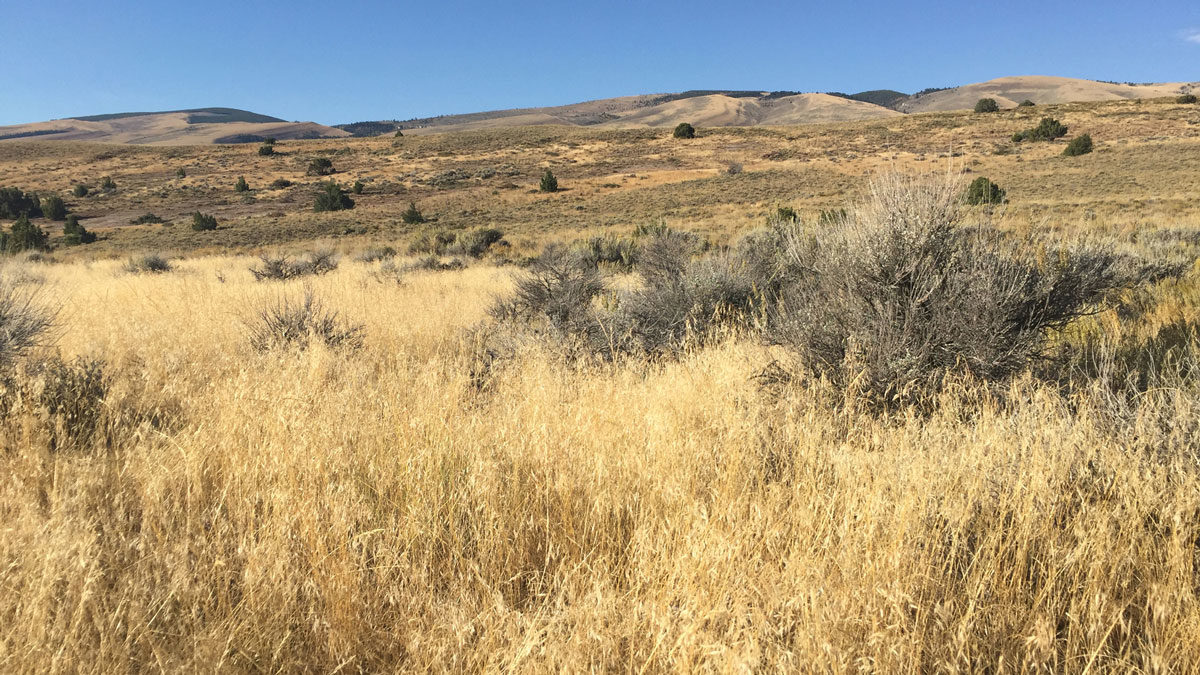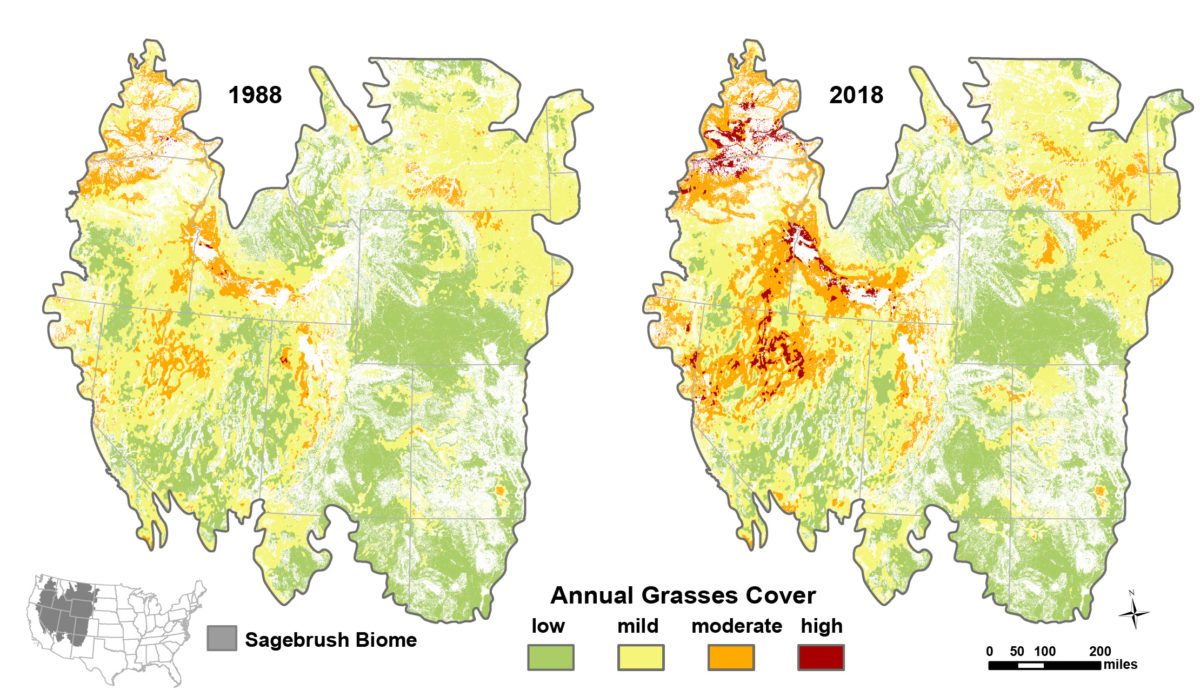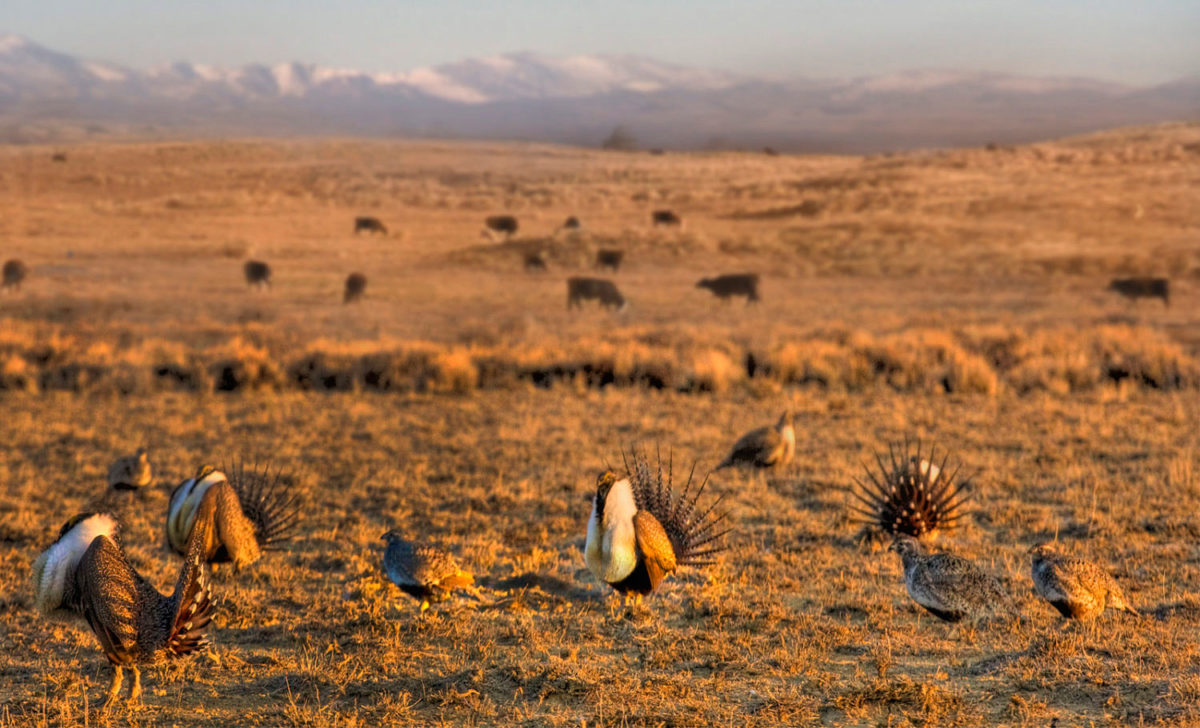Cheatgrass-invasion-WY-H-Copeland-1200-web
Do you have any thoughts on this post?
Before smoke filled the sky this wildfire season, an unwanted invader was already crowding out wildlife food sources in sagebrush country—now, it’s burning
With more than 20 major fires and hundreds of smaller ones burning over a million and a half acres in California alone, it’s shaping up to be a long and expensive wildfire season—for people, wildlife, and habitat.
Fire can, of course, be good for forests, grasslands, and sagebrush when it keeps invading conifer trees at bay, adds nutrients to the soil, revitalizes forbs and bunchgrasses, and creates a mosaic of favorable habitat conditions. This assumes a normal ecological cycle of growth and renewal over many years.
But an invasive menace has changed much of the West’s fire cycle, especially across the sagebrush sea, damaging the very habitat that supports more than 350 species of plants and animals, including sage grouse.
That menace is cheatgrass, and it represents one of the greatest threats to this uniquely Western landscape. Here’s why.
While there are many non-native plants that have spread across the country, none rival the destructive impact of cheatgrass.
Though it’s an annual species—meaning that it lives for just one growing season and then dies—cheatgrass produces enormous amounts of seed that remain viable for many years and germinate quickly under the right conditions. Cheatgrass spreads easily by wind but is also carried by a wide range of mammals that get its barbed seeds stuck in their fur. This is also how the seeds travel on a hiker or hunter’s boots and socks!
From there, cheatgrass can quickly and efficiently dominate disturbed areas of bare ground.
Native to parts of Europe, southwestern Asia, and northern Africa, cheatgrass was first discovered here in New York and Pennsylvania in 1861. By the late 1920s, it had spread across the country, finding especially favorable conditions in the fragile, dry shrublands of the Great Basin, Columbia River Basin, and across the Intermountain West.
This is where it has put a stranglehold on native plants important to at-risk sagebrush species, altering ecological processes and changing the way wildlife use their environment.
Cheatgrass can easily overtake a landscape and outcompete native plants, often creating vast monocultures. The grass itself has little to no value as forage or cover for wildlife, but it decimates the forage available to both wildlife and livestock, which can have serious consequences for ranching operations. And without diverse perennial forbs and bunchgrasses—those that live for more than one growing season—there is little to hold the soils together and retain moisture.
But perhaps the most pervasive impact of cheatgrass domination has been its influence on the size, intensity, and natural cycles of wildfire, especially in the sagebrush sea.

While large and sometimes severe wildfires historically burned in sagebrush, they were infrequent and returned only every 60 to 100 years, depending on elevation, soil moisture, and other conditions. Native forbs, grasses, and sagebrush evolved with fire and adapted to this interval between blazes. Up until just a few decades ago, wildfires usually burned less intensively and more sporadically across the landscape, thereby creating more diversity in the age and structure of sagebrush plants while maintaining the bunchgrasses and forbs that are so valuable as cover and forage for wildlife.
But that has largely changed in areas plagued by cheatgrass invasion. Cheatgrass dies just in time for a typical fire season to start and is an extremely flashy fuel—one that can turn a simple lightning strike or discarded cigarette butt into a raging inferno in minutes.
When cheatgrass dominates an area and a fire gets started, it is almost equivalent to spreading gasoline across the surrounding vegetation.
Today’s fires are becoming hotter and more frequent in part because of the dominance of cheatgrass. Hotter fires mean that more sagebrush and other native plants that are not adapted to frequent high-intensity fires will certainly be lost. The soil is damaged, which weakens the system’s ability to regenerate sagebrush and perennial forbs and bunchgrasses.
Worse yet, after a hot fire, the disturbed soils are ripe for re-invasion by—you guessed it—cheatgrass.
Scientists now estimate that fire in cheatgrass-dominated areas can return every five years or less as a result of this broad ecological change. These areas may never return to their native condition and can essentially become biological deserts. And each year, the vicious cycle continues and results in more and more sagebrush and other habitats being dominated by this invasive species.

A bird hunter is never going to pull up to a huge burned area of sagebrush and unload the dogs, but many Western big game hunters know that a few years after a fire sweeps through a landscape, these areas can become prime habitat for elk and mule deer. This is especially true for forests with so much canopy coverage that sunlight couldn’t reach the ground and regenerate vegetation that big game like to eat.
In a normal cycle of fire and regrowth, yes, this balance is restorative. But the new normal of catastrophic blazes and cheatgrass-driven fires can severely alter winter range and other big game habitats.
There is major concern about the impact of fire on the survival of sage grouse, in particular. According to the Bureau of Land Management, more than 15 million acres of sagebrush burned across the West from 2000 to 2018.
While some of those acres may have been restored naturally or with human intervention, many are now part of the perpetual and unrelenting cheatgrass-fire cycle, which does not bode well for deer, pronghorns, elk, or sage grouse.

In our own lives, we know it’s cheaper and easier to take care of ourselves—eat right, stay active, and get preventative screenings—than to wait for a crisis to send us to the emergency room. The same is true of maintaining rangeland health.
Once cheatgrass takes hold of a landscape, it is extremely difficult and expensive to eradicate. The problem may be widespread at this point, but it hasn’t completely taken over all habitats in all places. Reactive measures in these areas should continue, but proactive measures to conserve and restore the resilience of native vegetation are more likely to succeed.
Fortunately, projects to prevent and remove cheatgrass invasion can create jobs at a time when many Americans are out of work. But decision-makers need to invest in these efforts to make a difference.
The cheatgrass-fire cycle is daunting, but cannot be ignored. We need more attention given to this crisis and state and federal resources to combat it. Failure to address this clear and present danger will have consequences for fish and wildlife habitat, soil health, forage diversity, and our Western economies that depend on healthy sagebrush ecosystems.
Failure to act may also mean watching our hunting and fishing opportunities go up in smoke.
Top photo by Nolan E. Preece/USFWS via flickr
After anglers turn up the heat, the Army Corps refuses to permit Alaska mine
The U.S. Army Corps of Engineers announced today that it will not permit the proposed Pebble Mine in southwest Alaska. The Corps released its decision finding the project “could have substantial environmental impacts within the unique Bristol Bay watershed.”
The decision goes on to state the mine “would likely result in significant degradation of the environment and would likely result in significant adverse effects on the aquatic system or human environment.”
“This announcement signals significant progress for preserving the world’s largest sockeye salmon spawning area,” said Whit Fosburgh, president and CEO of the Theodore Roosevelt Conservation Partnership. “We hope the EPA will follow suit and stop the Pebble Mine once and for all. There is no safe way to advance this project and preserve the region’s thriving fishing and hunting economy. It’s time to put Pebble Mine to bed for good.”
TRCP and the American Sportfishing Association launched a TV ad on Fox News last week urging the president to oppose the Pebble Mine and protect the thousands of jobs that rely on this world-renowned salmon fishery. This follows up on more than two decades of work trying to stop the mine by a diverse coalition of conservationists, anglers, local businesses, and Alaska-Native tribes.
Alaska’s Senators Lisa Murkowski and Dan Sullivan issued statements today hailing the decision and signaling an increase in bipartisan support for stopping the mine.
Photo courtesy: Fly Out Media
The Chesapeake Bay watershed is a lifeline to 18 million people and 3,600 species of animals and plants. Its impact reverberates not just in the immediate Bay, but in the six states (Delaware, Maryland, New York, Pennsylvania, Virginia, and West Virginia) and District of Columbia, that feed it.
The watershed’s connectivity to major urban environments and working agricultural lands have contributed to massive amounts of pollution flowing into the Bay significantly harming water quality and negatively impacting the fish and wildlife. Every year, a dead zone forms along the mainstem of the Chesapeake Bay, occupying about 40 percent of its area and up to 5 percent of the Bay’s water volume.
A Commitment to Clean-Up
While the states worked for decades to try to clean up the Bay and the waterways that fed it, efforts were coming up short. So in 2010, the federal government stepped in to help create a plan to clean up the Bay by 2025. The Chesapeake Bay Total Maximum Daily Load (TMDL) established pollution benchmarks that the states would have to meet. In order to achieve those goals, each state developed Watershed Implementation Plans, which have been updated over time. States are currently on Phase 3 of their Watershed Implementation Plans.
Unfortunately, it appears as if Pennsylvania is at risk of falling short. This is deeply troubling since most of the pollutants entering the Bay come from Pennsylvania. For example, the Susquehanna River, which flows from New York through Pennsylvania and into Maryland, provides about half of the water for the Chesapeake Bay. A 2020 preliminary report by Pennsylvania’s Department of Environmental Protection found that 30 percent (25,850 stream miles) of Pennsylvania portion of the Susquehanna River is impaired.
To meet its nitrogen reduction goals, Pennsylvania needs to reduce the amount of nitrogen that it releases into the Bay by 34 million pounds, but under its Phase 3 Watershed Implementation plan, it will only be able to cut two-thirds of that pollution.
Barriers to a Better Bay
So, what is preventing Pennsylvania from meeting its goal? Well, in order to meet its pollution reduction benchmark, Pennsylvania would need to invest an additional $257 million a year into its Bay waterways. We think this is a wise investment, given that the Bay filters drinking water for 75 percent of watershed residents.
Unfortunately, Pennsylvania state lawmakers tried to pass legislation that would freeze or redirect funding for some of the state’s most effective conservation programs.
We know that policymakers are under mounting pressure as they deal with coronavirus impacts and the ensuing economic fallout, but now is not the time to cut job-creating investments. The Bay contributes billions of dollars to our economy every year.
So what can hunters and anglers do?
Because different versions of each bill have been passed by the House and Senate, conference committees will debate which provisions move forward.
Considering the recent wins we’ve been able to celebrate for conservation—some that have been on our community’s bucket list for decades—it would be cynical to think that sportsmen and women are not being heard by decision-makers right now. If we continue to show up with practical solutions, we can continue to expect victories for fish and wildlife habitat, hunting and fishing opportunities, and our outdoor recreation businesses.
In that spirit, we’re watching two bills very closely as they move into a final phase of debate: The Water Resources Development Act and what’s generally referred to as a Highway Bill. Congress has a responsibility to pass these packages every few years—unlike a Great American Outdoors Act, for example, that goes through the process only once.
Here’s what’s at stake and what success could look like.
The Legislation: The Water Resources Development Act is a must-pass two-year bill that authorizes water conservation and enhancement projects, many with benefits for fish and wildlife habitat.
How We Got Here: The America’s Water Infrastructure Act of 2020, with the Senate’s WRDA provisions, passed out of committee in May 2020. The House WRDA passed in a voice vote on the floor in late July.
What Sportsmen and Women Need Out of Negotiations: To safeguard America’s fish and wildlife habitat, it’s critical that the final bill takes meaningful steps forward on managing invasive species, addressing harmful algal blooms, and increasing the use of natural infrastructure that can improve fish and wildlife habitat while also addressing challenges like floods, sea level rise, and coastal land loss.
Both the House and Senate bills contain provisions that we like, and many have to do with clearing the way for more natural or nature-based infrastructure solutions. Reminder: This could mean anything from restoring wetlands that can better filter annual floodwaters to reversing coastal erosion by diverting river sediment that needs to be removed to areas that desperately need it.
These natural solutions boost habitat, are often more cost effective, and age better than traditional “gray” infrastructure, but planning for them requires more than just a mindset shift—WRDA can help outline the policies and procedures that ensure these projects stand up to cost-benefit analyses and ultimately get the green light from federal agencies.
If you’re interested in a deep, section-by-section breakdown of what we like in the House and Senate bills, 14 other organizations joined us in sending this letter to Congress with the details.
The Legislation: The five-year Highway Bill expires in a little over a month, and the clock is ticking on new legislation that authorizes projects related to our road systems. Especially at a time with record unemployment, considering conservation benefits at the start of these projects can help put Americans back to work.
How We Got Here: The Senate bill saw action and approval at the committee level last summer. The House worked its Highway Bill, the INVEST in America Act, into H.R. 2, the Moving Forward Act, which passed on July 1, 2020.
What Sportsmen and Women Need Out of Negotiations: This must-pass legislation presents an opportunity to energize the American economy, improve habitat connectivity and water quality, enhance public safety, and even expand hunter and angler access.
We especially like the House language and Senate funding levels set for states to prioritize, study, and build wildlife-friendly highway crossings—like overpasses, underpasses, culverts, and fences to funnel wildlife away from roads. These structures save human and animal lives and can connect migration routes disrupted by roadways.
It’s encouraging to see both chambers prioritize investments in wildlife crossings, but we’re pushing negotiators to adopt the Senate’s program, which guarantees new dedicated funding for projects, rather than diverting money from other programs. The Senate version also makes sure that states with smaller populations – often the ones with the greatest need for wildlife crossings – have access to the funds.
As in the water resources bill, conference negotiators can also do more for fish and wildlife while addressing the country’s infrastructure challenges. The TRCP is supportive of provisions that would invest in and authorize programs that prioritize natural infrastructure solutions, enhance water quality, and bolster drought resilience.
In particular, $500 million should be appropriated to the Army Corps of Engineers to complete a backlog of projects with habitat benefits that have already been authorized. Funding proposed for state support—including an increase for the Clean Water State Revolving Fund, with 15 percent carved out specifically for natural infrastructure projects—should be included in the final bill, along with authorization for watershed recovery efforts in the Great Lakes, Chesapeake Bay, and Colorado River Basin.
Other important provisions include reauthorization of successful habitat and access programs, including those that support sportfishing, recreational boating, coastal resilience, forest management, conservation funding solutions, and improving outdoor recreation access for underserved communities.
Obviously, between the two bills and a very busy congressional calendar this fall, there is a lot at stake for hunters and anglers. Sign up to receive our emails so you don’t miss a single update.
This blog was co-authored by Kristyn Brady, Andrew Wilkins, and Kim Jensen.
Theodore Roosevelt’s experiences hunting and fishing certainly fueled his passion for conservation, but it seems that a passion for coffee may have powered his mornings. In fact, Roosevelt’s son once said that his father’s coffee cup was “more in the nature of a bathtub.” TRCP has partnered with Afuera Coffee Co. to bring together his two loves: a strong morning brew and a dedication to conservation. With your purchase, you’ll not only enjoy waking up to the rich aroma of this bolder roast—you’ll be supporting the important work of preserving hunting and fishing opportunities for all.
$4 from each bag is donated to the TRCP, to help continue their efforts of safeguarding critical habitats, productive hunting grounds, and favorite fishing holes for future generations.
Learn More
